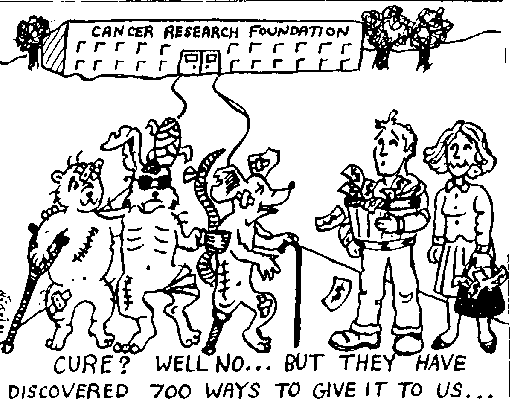Give ’em an Inch
by
Will future generations come to perceive life as mere chemicals, manufactured processes or inventions of no greater value than industrial products? Or will we act to respect life, by resisting the ultimate temptation to turn living things into pure utility?—Jeremy Rifkin.
The previous article on plant patenting used up so much paper whining about tomato plants that it didn’t get to the real gristle of the problem which is that they have also started giving patents on animals. It shows that if you give them an inch, they’ll take the whole tamale and run with it.
It took the rich guys about 200 years to convince the Congress that plants, like everything else in America, ought to be for sale. Then not 20 years later–the big day was 3-3-87–some unelected, bureaucrat dunderheads at the Patent and Trademark Office, without so much as a kiss-my-ass or a thank you, gave Harvard University a patent on a mouse. Harvard, actually, was just toadying for the Dupont Corp., which got the patent and now makes the cash.
Dr. Michael Fox called this deal “an arrogant presumption of authority.” I, Tiger Tom, call it a crock of human-centered speciesism. Business as usual.
This was the first-ever patent on an animal, if you can really call a mouse an animal. They named it the OncoMouse, because they made it by putting a human oncogene into a mouse embryo. The wonderful OncoMouse, the first “transgenic” animal to be patented (transgenic, for you non-scientists, means freaky and screwed up), is a sizzling item in research labs because it is easy to give it cancer. I, Tiger Tom, declare that this is real progress in the War on Cancer: They haven’t done jack shit, it is true, to cure cancer, but they have got very good at giving cancer to mice and other animals unfortunate enough to fall into their clutches.
Oncos sell for $50 a head, which by the pound makes their flesh at least 8,888 times more expensive than cow meat. Since the OncoMouse they have whipped up lots more wonderful animals. One article I read tells how they put human genes into pig genomes to create bigger and leaner superpigs; what they got, though, were some pigs that had arthritis. They were “stunted, crippled, cross-eyed and sterile.” Too bad they were sterile. Otherwise we could have a whole race of cross-eyed, gimpy porkies running around.
Another animal they thought up was a girl chicken with her genetic trait for “brooding” removed; they hope she will put out 20% more eggs since she doesn’t have to waste time trying to satisfy her “mother instinct.”
I read another article about a Texas rancher making calves that are “leaner and milkier” by putting human genes into the embryo. He said this is important work to prevent disease because these calves could grow up to be big and meaty without steroids, “which have been linked to heart disease and impotence.” Same rancher, probably, who used to say steroids were safe as Ivory soap. Now the boy is a regular health nut.
In France a bunch of savants (that’s French for wise-asses) grafted quail embryo brain tissue into chicken embryo brain tissue to make a weird quail-chicken or chicken-quail, depending on your preference. Probably they hoped to make big, slow hunting birds, easy to shoot and with fleshy drum sticks. But all the birds died two weeks after hatching because their immune system rejected their brain. Brain rejection is a real bummer, but they’ll surely get a big grant to buy a lot of OncoMice with baboon brains so they can work on a drug for it.
What really melts my stripes is how human people are so good at rationalizing this stuff. No one but Mike Fox, Jeremy Rifkin (one of the five or six really smart people around) and a couple of others consider there might be something a tiny bit unethical about mixing human parts with other animals. If the Church of Science says it’s OK, then it’s OK. And if it makes Money, the Church of Science always says it’s OK.
By 1990 human genes had been put into at least 16 animals, mostly pigs, mice, and fish. The priests of the Church of Science go on playing the same old mind game they always play about animal research. They say, these things are just like people: if it works on them, it will work on us; but if you tell them that what they are doing is cruel, they say, oh, these things aren’t like people–they don’t have any feelings. Now they are putting human parts into mice and pretending that they are doing experiments on mice but not on people. I, Tiger Tom, ask you to consider: how many human genes do you add before a mouse stops being a mouse and starts being human? How many human body parts and genetic traits do you have to transplant into bovines before you stop eating cows and start eating people? And when are they going to start granting patents on people? When will they start breeding special research people who are just like people but have no feelings or mother instinct and get cancer very easily?






